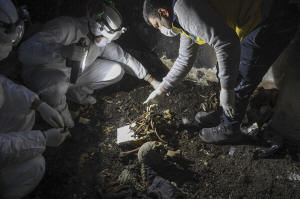The discovery of brutal mass graves in Syria reveals Assad's legacy of
horror
 Send a link to a friend
Send a link to a friend
 [January 29, 2025]
By OMAR ALBAM AND SALLY ABOU ALJOUD [January 29, 2025]
By OMAR ALBAM AND SALLY ABOU ALJOUD
DAMASCUS, Syria (AP) — The charred remains of at least 26 victims of the
Bashar Assad government were located Tuesday by Syrian civil defense
workers in two separate basements in rural Damascus.
The discovery adds to the growing tally of mass graves unearthed since
the fall of the Assad government in December. The remains, which are
believed to include men, women and children, showed evidence of gunshot
wounds and burning.
Members of Syria’s White Helmets, a volunteer civil defense group,
exhumed the fragmented, weathered skeletal remains from the basement of
two properties in the town of Sbeneh, southwest of the capital. Wearing
hazmat suits, they carefully logged and coded each set of remains before
placing them into body bags, which were then loaded onto trucks for
transport.
Since Nov. 28, the White Helmets have uncovered "more than 780 bodies,
most of unknown identity,” Abed al-Rahman Mawwas, a member of the rescue
service, told The Associated Press. He said many were found in shallow
graves uncovered by locals or dug up by animals. The bodies are
transferred to forensics doctors to determine their identities, time of
death and cause of death, as well as to match them with possible family
members.
“Of course, this takes years of work,” he said.
Mohammad al-Herafe, a resident of one of the buildings where remains
were uncovered, said the stench of decomposing bodies was overwhelming
when his family returned to Sbeneh in 2016 after fleeing because of
fighting in the area during the country's uprising-turned-civil war that
began in 2011.

He said they found the bodies in the basement but chose not to report it
out of fear of government reprisals. “We could not tell the regime about
it because we know that the regime did this.”
The Assad government, which ruled Syria for over two decades, employed
airstrikes on civilian areas, torture, executions and mass imprisonment,
to maintain control over Syria and suppress opposition groups during the
country's 13-year civil war.
Ammar al-Salmo, another Civil Defense member dispatched to the second
basement site, said further investigation is needed to identify the
victims.
“We need testimonies from residents and others who might know who stayed
behind when the fighting intensified in 2013,” he told the AP.
Mohammad Shebat, who lived in the second building where bodies were
found, said he left the neighborhood in 2012 and returned in 2020 when
he and his neighbors discovered the bodies and demanded their removal.
But no one cooperated, he said.
[to top of second column]
|

Syrian civil defense workers, known as the White Helmets, collect
human remains found in two separate basements in Sbeneh, outskirts
of Damascus, Syria, Tuesday, Jan. 28, 2025. According to the White
Helmets, the charred remains belong to at least 26 victims of the
Bashar Assad regime. (AP Photo/Omar Albam)

Shebat believes the victims were civilians who fled the nearby Al-Assali
neighborhood when the fighting escalated and the Assad government
imposed a siege in 2013. He said forces of the former government
used to “trap people in basements, burn them with tires and leave
their bodies.”
“There are several basements like this, full of skeletons," he said.
In a report released Monday, the United Nations Syria Commission of
Inquiry said that mass graves can be used as evidence to uncover the
fates of thousands of missing detainees.
The report, spanning 14 years of investigations and drawing on over
2,000 witness testimonies, including more than 550 survivors of
torture, detailed how detainees in Syria’s notorious prisons
“suffering from torture injuries, malnutrition, disease and illness,
were left to die slowly, in agonizing pain, or were taken away to be
executed.”
Assad's fall on Dec. 8 drove hundreds of families to scour prisons
and morgues in desperate search of loved ones. While many were freed
after years of imprisonment, thousands remain missing, their fates
still unknown.
The U.N. commission has said that forensic exhumations of mass
graves, as well as safeguarding evidence, archives and crime sites,
may offer grieving families a chance to learn the truth.
The commission was established in 2011 by the Human Rights Council
to investigate Syria’s alleged violations of international human
rights law.
The U.N. report documented brutal methods of torture by the former
government, including “severe beatings, electric shocks, burning,
pulling out nails, damaging teeth, rape, sexual violence including
mutilation, prolonged stress positions, deliberate neglect and
denial of medical care, exacerbating wounds and psychological
torture.”
“For Syrians who did not find their loved ones among the freed, this
evidence, alongside testimonies of freed detainees, may be their
best hope to uncover the truth about missing relatives,” said
Commissioner Lynn Welchman.
___
Abou AlJoud reported from Beirut.
All contents © copyright 2025 Associated Press. All rights reserved |